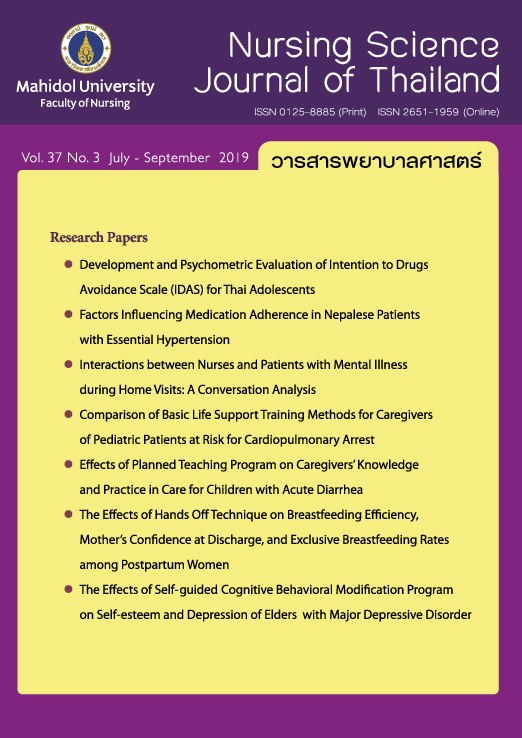ปฏิสัมพันธ์ระหว่างพยาบาลและผู้รับบริการที่มีปัญหาทางจิตระหว่างการเยี่ยมบ้าน การวิเคราะห์การสนทนา
Main Article Content
บทคัดย่อ
วัตถุประสงค์: การศึกษาครั้งนี้มีวัตถุประสงค์เพื่อสำรวจรูปแบบการสื่อสารระหว่างพยาบาลและผู้รับบริการที่มีปัญหาทางจิตจากการปฏิสัมพันธ์ที่เกิดขึ้นระหว่างการเยี่ยมบ้านเพื่อประเมินอาการผู้ป่วยประจำปี
รูปแบบการวิจัย: การวิจัยเชิงคุณภาพแบบใช้การสังเกต
วิธีดำเนินการวิจัย: การศึกษาแบบใช้การสังเกตได้ดำเนินการในปี พ.ศ. 2560 ระหว่างการเยี่ยมบ้าน ของผู้รับบริการที่มีปัญหาทางจิต ในจังหวัดหนึ่งของภาคตะวันออกเฉียงเหนือ ประเทศไทย ข้อมูลการปฏิสัมพันธ์ระหว่างพยาบาลจำนวน 4 คน และผู้รับบริการจำนวน 6 คน ถูกรวบรวมด้วยเครื่องบันทึกเทปวีดีทัศน์ รวมระยะเวลาที่ใช้ในการบันทึก 32.2 ชั่วโมง การวิจัยนี้วิเคราะห์ปฏิสัมพันธ์ระหว่างพยาบาลและผู้ป่วยด้วยเทคนิคการวิเคราะห์บทสนทนา
ผลการวิจัย: ผลการวิเคราะห์พบว่า พยาบาลเป็นฝ่ายควบคุมการสนทนาเป็นส่วนใหญ่ จากบทสนทนาบางครั้งผู้รับบริการมีการขัดจังหวะการสนทนาและพูดน้อย เนื่องจากคำถามส่วนใหญ่เป็นแบบปลายปิด ผู้รับบริการมักใช้การหยุดสนทนา การใช้ความเงียบ และการเปลี่ยนเรื่องของการสนทนาเพื่อหลีกเลี่ยงการสนทนาเรื่องไม่พึงประสงค์
สรุปและข้อเสนอแนะ: ในเชิงทฤษฎี ปฏิสัมพันธ์ระหว่างพยาบาลและผู้รับบริการจะมุ่งเน้นรูปแบบการสื่อสารที่ยึดผู้รับบริการเป็นศูนย์กลาง ในขณะที่ผลการศึกษานี้พบว่า พยาบาลควบคุมการสนทนาโดยมีหัวข้อการสนทนาเกี่ยวข้องกับงานของพยาบาลเป็นหลัก การศึกษานี้บ่งชี้ถึงความจำเป็นของการฝึกอบรมเพื่อพัฒนาทักษะการสื่อสารที่ให้ผู้ป่วยเป็นศูนย์กลางให้แก่พยาบาลระหว่างการเยี่ยมบ้าน
Article Details
ลิขสิทธิ์: วารสารพยาบาลศาสตร์เป็นเจ้าของลิขสิทธิ์ในการเผยแพร่ผลงานที่ตีพิมพ์ ห้ามผู้ใดนำบทความที่ได้รับการตีพิมพ์ในวารสารพยาบาลศาสตร์ไปเผยแพร่ในลักษณะต่างๆ ดังต่อไปนี้ การส่งบทความไปตีพิมพ์เผยแพร่ที่อื่น การนำบทความเผยแพร่ออนไลน์ การถ่ายเอกสารบทความเพื่อกิจกรรมที่ไม่ใช่การเรียนการสอน ยกเว้นเสียแต่ได้รับอนุญาตจากวารสารพยาบาลศาสตร์

Disclaimer: เนื้อหาบทความหรือข้อคิดเห็นใดๆ ในวารสารพยาบาลศาสตร์ ถือเป็นความรับผิดชอบของผู้เขียน กองบรรณาธิการไม่จำเป็นต้องเห็นด้วยและไม่มีส่วนรับผิดชอบแต่อย่างใด
เอกสารอ้างอิง
2. Grabowski DC, Aschbrenner KA, Rome VF, Bartels SJ. Quality of mental health care for nursing home residents: a literature review. Med Care Res Rev. 2010;67(6):627-56.
3. Ammerman RT, Putnam FW, Bosse NR, Teeters AR, Van Ginkel JB. Maternal depression in home visitation: a systematic review. Aggress Violent Behav. 2010;15(3):191-200.
4. Kane JM, Kishimoto T, Correll CU. Non-adherence to medication in patients with psychotic disorders: epidemiology, contributing factors and management strategies. World Psychiatry. 2013;12(3):216-26.
5. Videbeck SL. Psychiatric-mental health nursing. 6th ed. Philadelphia, PA: Wolters Kluwer Health/Lippincott Williams & Wilkins; 2014. 652 p.
6. Jones A. Nurses talking to patient: exploring conversation analysis as a means of researching nurse-patient communication. Int J Nurs Stud. 2003;40(6):609-18.
7. Sefi S. Health visitors talking to mothers. Health Visit. 1988;61(1):7-10.
8. Cornaggia CM, Di Rosa G, Polita M, Magaudda A, Perin C, Beghi M. Conversation analysis in the differentiation of psychogenic nonepileptic and epileptic seizures in pediatric and adolescent settings. Epilepsy Behav. 2016;62:231-8. doi: 10.1016/j.yebeh.2016.07.006.
9. Hakimnia R, Holmstrom IK, Carlsson M, Hoglund AT. Exploring the communication between telenurse and caller: a critical discourse analysis. Int J Qual Stud Health Well-being. 2014;9:24255.doi: 10.3402/qhw.v9.24255.
10. Dowell A, Stubbe M, Macdonald L, Tester R, Gray L, Vernall S, et al. A longitudinal study of interactions between health professionals and people with newly diagnosed diabetes. Ann Fam Med. 2018;16(1):37-44.
11. Mayor E, Bietti L. Ethnomethodological studies of nurse-patient and nurse-relative interaction: a scoping review. Int J Nurs Stud. 2017;70:46-57.
12. Holloway I, Wheeler S. Qualitative research in nursing and healthcare. 3rd ed. West Sussex, UK: Wiley-Blackwell; 2010. 304 p.
13. Sidnell J. Conversation analysis: an introduction. West Sussex, UK: Wiley-Blackwell; 2010. 376 p.
14. Sacks H, Schegloff EA, Jefferson G. A simplest systematics for the organization of turn-taking in conversation. Language.194;50(4):696-735.
15. Drew P, Heritage J. Analyzing talk at work: an introduction. In: Drew P, Heritage J. editors. Talk at work: interaction in institutional settings. Cambridge: Cambridge University Press; 1992. 65 p.
16. Tapanya S. Psychology in medical settings in Thailand. J Clin Psychol Med S. 2001;8(1):69-72.
17. Kitreerawutiwong N, Jordan S, Hughes D. Facility type and primary care performance in sub-district health promotion hospitals in Northern Thailand. PLoS One. 2017;12(3):e0174055 doi: 10.1371/journal.pone.0174055.
18. Jefferson G. Glossary of transcript symbols with an introduction. In: Lerner GH, editor. Conversation analysis studies from the first generation. Amsterdam/Philadelphia: John Benjamins; 2004. p.13-31.
19. Chadchaidee TL. Thailand in my youth. Bangkok: BooksMango; 2014. 172 p.
20. Wynn R. Provider-patient interaction: a corpus-based study of doctor-patient and student-patient interaction. 6th ed. Kristiansand, NO: Hoyskoleforlaget Norwegian Academic Press; 1999. 292 p.
21. Zimmerman DH, West C. Sex roles, interruptions and silences in conversation. In: Thorne B, Henley N. editors. Language and sex: difference and dominance. Rowley, MA: Newbury House; 1975. p.105-129.
22. Aquino AM. Speech and oral communication for nursing. Manila: Rex Book Store; 2008. 386 p.
23. Borg J. Talk ability: discover the secrets of effective conversation. London: Pearson Business; 2016. 256 p.
24. Gardezi F, Lingard L, Espin S, Whyte S, Orser B, Baker GR. Silence, power and communication in the operating room. J Adv Nurs. 2009;65(7):1390-9.
25. Peplau HE. Interpersonal relation in nursing: a conceptual frame of reference for psychodynamic nursing. New York, NY: Springer; 1991. 360 p.


